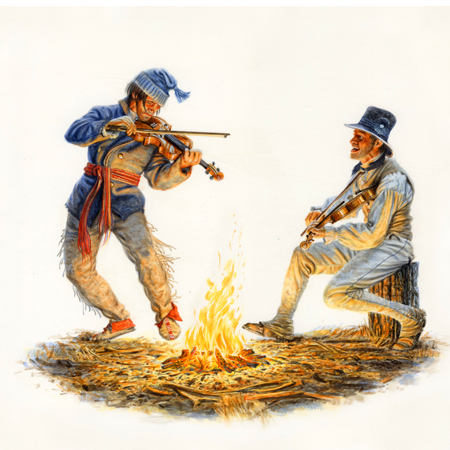Cruzatte (left) and Gibson (right)
© Michael Haynes, https://www.mhaynesart.com. Used with permission.
The principal catalyst for their musical diversions was undoubtedly Private Pierre Cruzatte. George Gibson, who specialized as a hunter and sign-language interpreter, played the fiddle too, on at least one occasion—at the party and dance the Wallulas held for the Corps on 19 October 1805.
Gibson, born in Pennsylvania, was living on the Kentucky frontier by the time Clark had recruited him in 1803. On the expedition, Gibson was one of the best hunters.
Gibson survived one of the Lewis and Clark Expedition’s most painful wounds. He also survived the failed first attempt to escort Chief Sheheke home to his Mandan village. But Gibson’s own life was cut short by syphilis, the era’s deadly medication for it, or the combination of both. Gibson’s injury occurred on July 18, 1806, along the Yellowstone River. Clark wrote:
Gibson in attempting to mount his horse after Shooting a deer this evening fell and on a Snag[,] and sent it nearly two inches into the Muskeler part of his thy. he informs me this Snag was about 1 inch in diamuter[,] burnt at the end. this is a very bad wound and pains him exceedingly. I dressed the wound.
After a nearly sleepless night, Gibson ached from knee to hip. Clark selected the gentlest horse, and the men piled skins and blankets on the saddle so that Gibson could nearly recline. But, after riding nine miles, Gibson’s leg was numb. Clark allowed Sgt. Nathaniel Pryor to stay behind with Gibson while he rested, then progress slowly to that night’s camp. Clark had been planning to have canoes made as soon as they located trees that were large enough, but now he wanted to get Gibson off horseback.
He selected a site near today’s Park City, Montana, where his group stayed until 24 July 1806 making dugout canoes. Clark hoped to apply a poultice of wild ginger to Gibson’s leg, but John Shields searched for two days without finding any. Happily, the wound did not infect. When two canoes had been built, Clark had them lashed together for stability, and his Yellowstone exploration continued.
At some point during the winter of 1804-1805, Gibson contracted syphilis from a neighboring Mandan or Hidatsa woman, who would herself have been infected by a visiting British or Canadian trader. This illness was not recorded at the time, but on 27 January 1806, Lewis wrote that he had just cured Goodrich of syphilis “as I did Gibson last winter by the uce of murcury.” Mercury treated only the symptoms, but did not cure syphilis, which progresses through “five distinct phases” including the fatal ending, according to physician David J. Peck. Further, Dr. Peck notes that syphilis is called “‘the great imitator’ for its numerous symptoms that mimic other diseases.”[1]David J. Peck, Or Perish in the Attempt: Wilderness Medicine in the Lewis & Clark Expedition (Helena, MT: Farcountry Press, 2002, 114.
Even though Lewis thought Gibson cured the previous year, the young man was frequently ill during the winter of 1805-1806 at Fort Clatsop: in December, dysentery and boils, in February a mysterious weakness that lasted for two weeks. On 10 February 1806, Willard brought the word from Salt Camp “that Gibson was so sick that he could not set up or walk alone and had desired him to ask us to have him brought to the Fort.”
The captains sent four men to retrieve Gibson, “who is so much reduced that he cannot stand alone and . . . they are obliged to carry him in a litter.” They arrived on 15 February 1806, and Lewis went to work sweating the “veery languid” Gibson with saltpeter and dosing him with laudanum for sleep. Notes on the continuing treatment continued for the next six days, with Lewis never considering that Gibson suffered from continuing syphilis.
Genealogist Larry E. Morris makes a convincing case that George Gibson was the “Gibson” who joined fellow Corps veterans Pryor and George Shannon and forty-five others (mainly trappers and boatmen) in the 1807 attempt to return Chief Sheheke home to his Mandan village.[2]Larry E. Morris, The Fate of the Corps: What Became of the Lewis and Clark Explorers After the Expedition (New Haven: Yale University Press, 2004), 29-30, 218n14. Morris notes that George Gibson is … Continue reading During the Arikara Indian attack that cost Shannon his leg, Gibson received a flesh wound from which he recovered. He returned to St. Louis, where he married Maria Reagan the following year.
In January 1809, Gibson was so ill that he wrote out his will, “being Vary Sick and weak in Strength but in perfect Mind and Memory thanks be given unto god,” and left all his possessions to Maria. He died by 10 July 1809. William Clark, possibly a visitor to their home during Gibson’s last months, assisted Maria in settling the estate.[3]Morris, 76-77, 193.
Notes
| ↑1 | David J. Peck, Or Perish in the Attempt: Wilderness Medicine in the Lewis & Clark Expedition (Helena, MT: Farcountry Press, 2002, 114. |
|---|---|
| ↑2 | Larry E. Morris, The Fate of the Corps: What Became of the Lewis and Clark Explorers After the Expedition (New Haven: Yale University Press, 2004), 29-30, 218n14. Morris notes that George Gibson is mentioned in an 1807 letter that also discusses advances paid to the men who had been wounded in Pryor’s Arikara fight: Frederick Bates to Dennis Fitzhugh, 16 December 1807, in Thomas Maitland Marshall, ed., The Life and Papers of Frederick Bates (St. Louis: Missouri Historical Society, 1926), 237. Bates served as Secretary of Louisiana Territory from 1806 through 1812. |
| ↑3 | Morris, 76-77, 193. |

